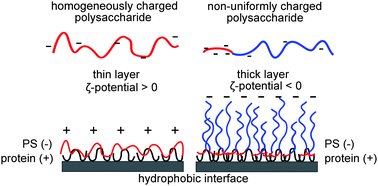Mixed protein–polysaccharide interfacial layers: effect of polysaccharide charge distribution
Abstract
The influence of the

* Corresponding authors
a
School of Food Science and Nutrition, University of Leeds, LS2 9JT Leeds, UK
E-mail:
r.ettelaie@leeds.ac.uk
b School of Physics and Astronomy, University of Leeds, LS2 9JT Leeds, UK
c Max-Planck-Institut fuer Polymerforschung, 55128 Mainz, Germany
The influence of the

 Please wait while we load your content...
Something went wrong. Try again?
Please wait while we load your content...
Something went wrong. Try again?
R. Ettelaie, A. Akinshina and S. Maurer, Soft Matter, 2012, 8, 7582 DOI: 10.1039/C2SM25803J
To request permission to reproduce material from this article, please go to the Copyright Clearance Center request page.
If you are an author contributing to an RSC publication, you do not need to request permission provided correct acknowledgement is given.
If you are the author of this article, you do not need to request permission to reproduce figures and diagrams provided correct acknowledgement is given. If you want to reproduce the whole article in a third-party publication (excluding your thesis/dissertation for which permission is not required) please go to the Copyright Clearance Center request page.
Read more about how to correctly acknowledge RSC content.
 Fetching data from CrossRef.
Fetching data from CrossRef.
This may take some time to load.
Loading related content
